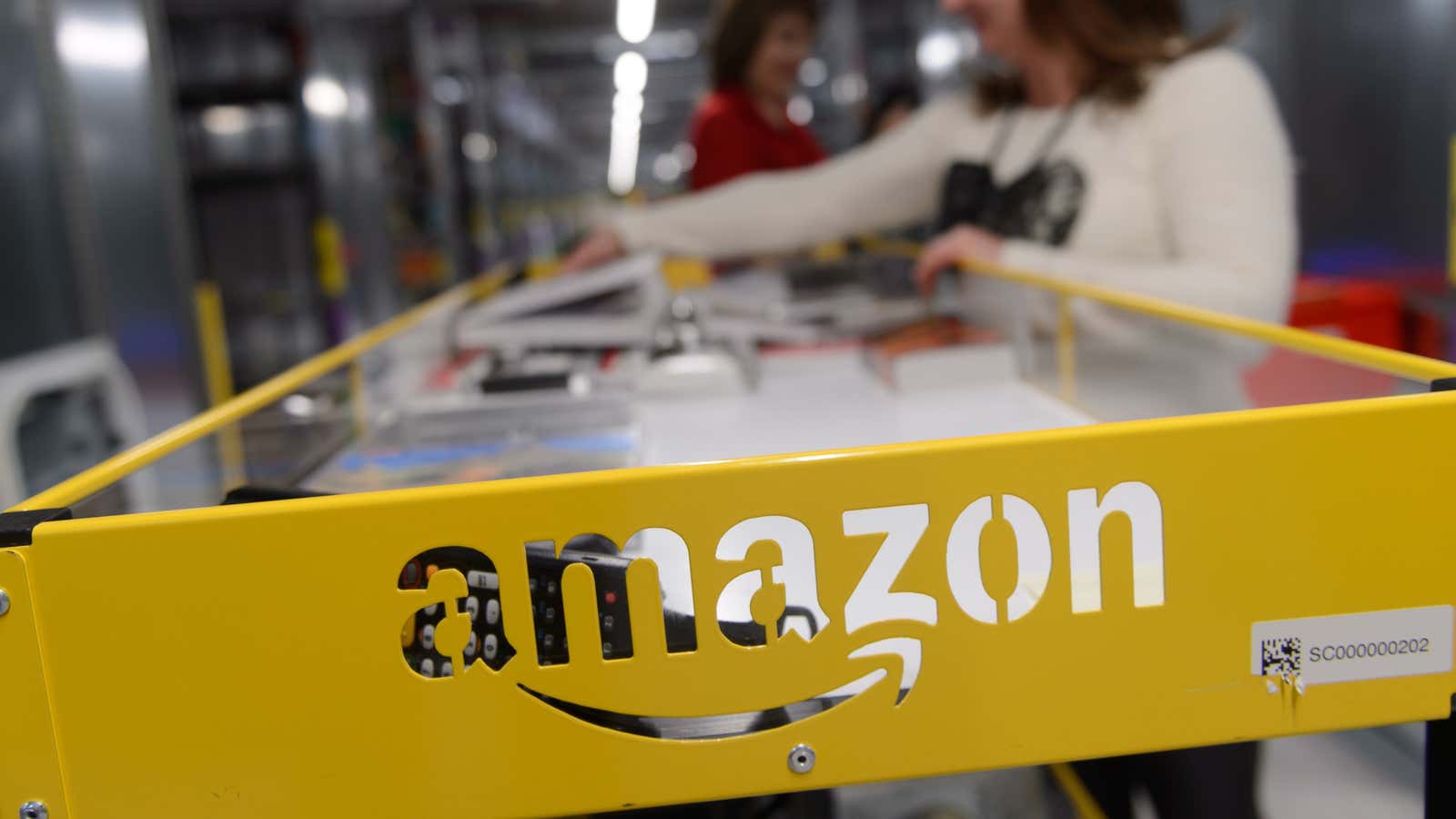Amazon posted a profit in the fourth quarter of 2016, but missed analyst expectations on revenue. Plans for global domination are still on, though.
On Thursday, the online retailer reported net sales of $43.7 billion for the fourth quarter of 2016, up 22% over the same quarter a year ago. Those numbers fell short of analyst expectations, sending Amazon’s stock down more than 4% in after-hours trading. When asked on the company’s earnings call about the revenue miss, Amazon CFO Brian Olsavsky said revenue would have been up 24% if not for an $800 million hit due to foreign exchange rates.
Net income for the quarter was $749 million, or $1.54 per share, compared with $482 million, or $1 a share, a year earlier. The company also issued guidance on first-quarter revenue and operating income that was below estimates.
While Amazon beat profit estimates—analysts had expected earnings of $1.37 per share—that’s no longer enough to satisfy its shareholders, who are looking for details on how Amazon Web Services and Amazon Prime are faring. The former added more than $3.5 billion to the company’s revenue in the fourth quarter, but sales growth continued to slow. (Amazon does not break out Prime metrics, much to investors’ chagrin.)
It may have been a mixed quarter, but Amazon still had a very busy 2016, much of which was spent laying down a foundation for future plans. On the hardware side, the company’s Echo speaker, which comes equipped with virtual assistant Alexa, has been a roaring success. Echo device sales grew nine-fold in the 2016 holiday season over the same period in 2015.
On its earnings call on Thursday, Amazon said it has added more than 4,000 Alexa “skills” since October, and added Alexa capabilities to its tablets and the Fire TV in the fourth quarter. More broadly, Alexa can also now be found in cars, smart fridges, and robots (and elsewhere). That proliferation has created a “great network effect,” Amazon director of investor relations Darin Manney said on the earnings call.
Amazon has also executed a massive expansive of Prime and Prime Video. The former launched in China in October, opening the door for Amazon to have an impact in the world’s most populous market. Prime Video is now available in more than 200 countries. Amazon has also made inroads in India, both by pumping huge amounts of money into the country and by creating local content with Bollywood’s biggest production houses.
Amazon warehouses shipped more than 2.5 billion units on behalf of sellers last year and, logistically speaking, the company is setting the stage for an even larger e-commerce and distribution presence: It wants to sell more types of products to more people, and deliver them faster than ever. Amazon spent $5.7 billion on fulfillment centers in the fourth quarter, up from $4.5 billion in the fourth quarter of 2015. Amazon also doubled the number of items it shipped for third-party vendors last year, which could also have contributed to revenue fall-off (Amazon makes more money shipping its own goods).
The company added 26 new warehouses last year (mostly in North America) and has started bolstering its fulfillment centers with a growing automated workforce. Last month, Amazon announced plans to create more than 100,000 full-time jobs in the US over the next 18 months.
On the delivery front, Amazon has literally taken flight, lining up a fleet of planes and managing its first drone delivery (a 13-minute journey in the UK to deliver an Amazon Fire stick and a bag of popcorn). Although the drone service is still in the testing phase, it may (rules permitting) soon expand to other parts of the world.
Seen altogether, Amazon’s initiatives seem geared at establishing itself the world’s top shopping resource, whether “shopping” means needing a book in two days or a bag of candy in two hours. Already, more people search Amazon than Google when looking for a product. While this kind of expansion takes time, and money, there’s already evidence that Amazon is figuring out the economics: In the fourth quarter, it spent $4.5 billion on fulfillment costs (i.e. getting stuff to customers), down from $5.7 billion in the same quarter last year.
Amid a sea of projects aimed at helping people shop from their couches, Amazon did have one unique proposition in 2016: a brick-and-mortar presence. In December, the company introduced Amazon Go grocery stores, which let shoppers buy items without a checkout, or any human interaction at all. It will soon open a drive-up grocery store in Seattle, and is slowly rolling out physical bookstores. During the earnings call on Thursday, Manney said more such locations are on the agenda: “We think the bookstores, for instance, are a really great way for customers to engage with our devices and see them, touch them, and become fans.”
